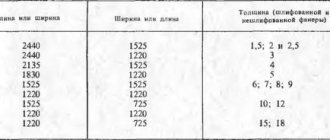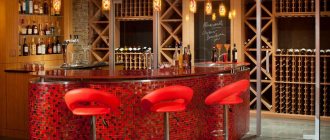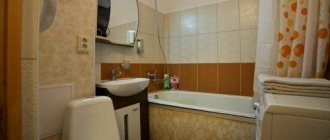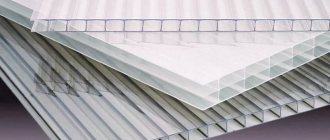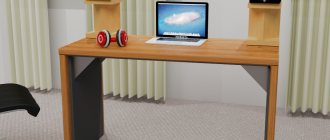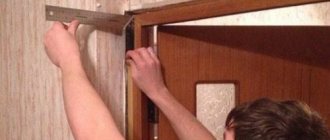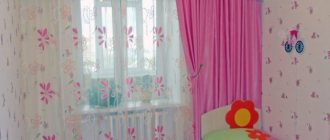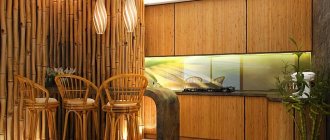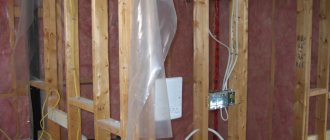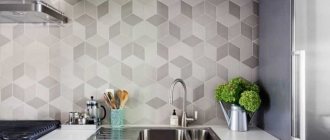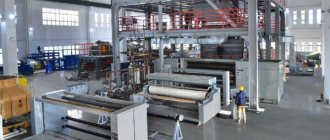During construction and during finishing work, it is often necessary to create a coating with improved properties - even, moderately durable. Chipboard (chipboard) has the necessary characteristics. The sheets are made from wood, but the base is not solid wood, but shavings. The slabs are susceptible to moisture, but this disadvantage is outweighed by their advantages. When choosing, you should consider different options for materials; they differ in appearance, properties, and therefore are used under different conditions.
Features of the material, history of appearance
Previously, the issue of recycling wood chips obtained during production for various purposes often arose. It was solved thanks to the appearance of slabs made from this raw material. Wood-based products first began to be used in the thirties of the last century. They were used for commercial purposes later - in the 40-50s. XX century Since then, the material has been used more and more often, and annual production has increased several times.
Raw materials: chipboard
Chipboard is a type of board made from shredded wood. They got their name due to the type of raw material that underlies them (wood shavings). Particles of different sizes are used, they are held together with a binder of non-mineral origin (synthetic glue, often based on phenol-formaldehyde resins). This feature limits the scope of application. The material contains a certain amount of toxic components, their dose is minimal, it is regulated by standards, and therefore the sheets are not prohibited. They are often used, including in the production of various pieces of furniture, and when performing finishing work.
Price of chipboards of different sizes
As you know, the cost of any building materials may change over time. This is influenced by many factors, including seasonality. In addition, in different cities and stores, prices for chipboard sheets may also differ.
Therefore, here we will indicate only the approximate cost in rubles (Moscow), which is valid at the time of writing this article.
Thus, the price of a chipboard sheet with a thickness of 16 mm and dimensions of 2750 × 1830 is currently about 800-1000 rubles. The cost of a sheet of the same thickness (16 mm), but 3500 mm long and 1750 mm wide can be about 50 rubles more.
If you want to more accurately find out the price of chipboard in your city, we recommend that you use search engines right now - for example, Yandex. Just type in a search engine the phrase “chipboard sheet sizes and price in Moscow” or something similar. You will be presented with a whole list of different sites (Online stores), where you will find detailed information about the product and its cost.
Also keep in mind that buying chipboard in an online store will cost you less. Some even provide free delivery of material within their locality.
Please also note that prices for chipboard can be both retail and wholesale. Therefore, when placing an order, please clarify this question.
Stages and features of production
To make chipboard, raw materials of different sizes and types are used:
- chips: they are produced on rotary-type machines;
- chips are the result of the operation of special equipment (for example, a chipper or a knife shaft).
To produce particle boards, you need raw materials whose particles correspond to standard parameters with deviations (to a lesser extent from the specified values):
- thickness – 0.5 mm;
- width – 5 mm;
- length – 40 mm.
The quality of the finishing material depends more on the thickness of the chips. It is better if it is as thin as possible. When specially harvested wood is used, rather than production waste, round timber or large boards will be needed. After preparation (removing the bark, dividing into smaller pieces, soaking), the material is crushed. This is how the raw materials are obtained, which are used to produce the top layer of the slab. Inside there are large chips, they are compressed, but in the section you can see the difference between the structure of the layers. To improve the quality of the raw material, it is additionally dried and sifted, then re-grinded.
Stages of plate production:
- All types of raw materials (for internal and external layers) require drying. This is done after calibrating it in size.
- The chips fall into the mixers, which are constantly rotating. Here it is mixed with binding components. It is important that every particle is coated with resin. This result is achieved by blowing a stream of air along with drops of the binder component. The resin envelops the chips.
- The mass falls on the conveyor belt, where future sheets are formed - layers of material of different thicknesses are created.
- The layer is cut into slabs and compacted using the vibrocompression method at a temperature of +180°...+220°C.
- Heating can increase the strength of the boards, which is achieved due to the effect of temperatures on the resin.
- Products are cooled. Moreover, to obtain materials with the desired properties, a gradual decrease in the temperature of the plates is required - in a natural way.
Overview of types of chipboard
In its original form, chipboard is used without additives, auxiliary layers, or structural elements. However, it is often necessary to use improved material. This led to the emergence of different types of slabs:
- laminated (laminated chipboard): coatings of several varieties are tried on (paper-resin film, plastic and paper-laminated material), which can affect the properties of the product;
laminated chipboard
- fire-resistant boards: contain fire retardants, making the material more resistant to high temperatures;
- moisture-resistant: they contain urea-melamine resins, hydrophobic polymer additives; boards of this type can be distinguished by their greenish tint;
Moisture-resistant chipboard
- veneered: similar to solid wood, but only externally, because the outside is covered with veneer, due to which the material imitates natural wood;
- tongue-and-groove (chipboard Quick Deck): they differ in the configuration of the cuts; grooves and tenons are formed here, making it possible to assemble a seamless durable coating.
Tongue-and-groove chipboards.
Separately, perforated boards should be noted. They are produced by extrusion. This type of material is used primarily in the production of door panels (laid inside), so it is not found on the open market. Features of such plates:
- presence of through holes;
- high sound insulation qualities;
- increased thermal insulation;
- resistance to deformation due to exposure to temperature changes.
The narrow scope of application of such chipboard is also due to its insufficiently high strength. Veneered material differs from this variety. For the coating, veneers of different species are used, but more often - oak, ash, which improves the quality of the slab, it becomes stronger, and better resists mechanical loads. Veneer, like lamination, gives the material decorative qualities. At the same time, wear resistance increases. At the same time, moisture resistance increases.
Important! Even if the material is covered with veneer or polymer film, this does not make it waterproof. Such slabs withstand exposure to a humid environment better. However, prolonged contact with water is not recommended. The material remains hygroscopic, depending on the type, it swells by 5-30%, which means it is deformed in such an environment.
Standard sizes
To purchase quality material, you need to know the standard parameters of the slabs. Today, slabs are produced with general parameters and additional (possible) sizes. The presence of different parameters provides a person with a wide range from which he can choose the appropriate option.
Chipboard
When choosing a material for construction or repair, you need to know the standard parameters of the boards.
According to GOST 10632-2014, the overall dimensions of the slab in length, width and thickness can be selected within the following limits:
- from 1800 to 5680 mm;
- from 1200 to 2500 mm;
- from 1 to 28 mm.
Sheet sizes may vary slightly.
Standard sheet parameters:
- 2750 x 1830 x 15 mm;
- 2440 x 1830 x 16 mm;
- 2620 x 1830 x 16 mm;
- 2440 x 1200 x 16 mm.
You can also choose chipboard in other sizes. More details in the table:
| Thickness (mm) | Length (mm) | Width (mm) |
| 10 | 2750 | 1830 |
| 16 | 2750 2440 3500 | 1830 1830 1750 |
| 18 | 2750 2440 2800 | 1830 1830 2070 |
| 22 | 2440 | 1830 |
| 25 | 2440 | 1830 |
| 28 | 2800 3050 | 1830 1830 |
It is important to know that in high-quality products, deviations from the norms should not exceed 0.3 mm in thickness and 5 mm in length and width.
Laminated chipboard
The quality of laminated boards is regulated by GOST.
The main dimensions are within:
- from 1830 to 5680 mm;
- from 1200 to 2500 mm;
- from 3 to 38 mm.
Depending on the capabilities of the equipment, each manufacturer produces several basic sizes of chipboard.
The most popular of them:
- 2800 x 2620 mm;
- 2800 x 2070 mm;
- 2620 x 1830 mm;
- 2500 x 1830 mm.
Classification
One of the first parameters that people pay attention to is the type of surface treatment. There are 2 options: sanded and unpolished slabs. They differ in the quality of the coating, which determines the area of application of the material. In addition, the slabs are distinguished by structure:
- ordinary (designated by the first letter – O);
- fine-textured (M).
The second option is used in the production of laminated boards. This is due to the fact that the film adheres better to the surface of such a product.
Surface quality
Slabs of different types are produced, differing in the number of defects:
- 1st grade – without changes in the structure of the material, defects;
- Grade 2 – a certain amount of damage is acceptable (regulated by regulatory documentation).
Due to average strength and moisture resistance, chipboard with more significant defects is not used, since it will not perform its main functions. The service life of the material will be significantly reduced.
Emission class
There are types of stoves that differ in the degree of danger to human health. They contain varying amounts of toxic components (in particular formaldehyde):
- E0.5;
- E1;
- E2.
Is chipboard harmful?
If you need to use the material indoors, only the first two options are considered. The concentration of formaldehyde in the structure of the binder component and when released into the surrounding space is minimal and is considered acceptable. However, the rule here is: the less, the better, so option E0.5 is preferable.
Strength level
There are types:
- P1 – general purpose;
- P2 – products intended for the manufacture of furniture and finishing work indoors.
The second option is more durable, so the scope of application of the slabs of this group is wider. P1 products are more often used for rough finishing, temporary structures or as auxiliary material. The strength of chipboard varies: 550-750 cubic meters. m. At the same time, the range of density values is also different: 0.5-1.0 g/cubic. see. Tensile strength is also taken into account:
- when bending – 10-25 MPa;
- when stretching - 0.2-03.5 MPa.
Which ones are better to choose?
When choosing furniture panels, you need to decide in advance about their purpose. For stable, massive structures, reinforced slabs with greater thickness will be required. Thin slab options are suitable for finishing work. Information about the two types of materials used in the manufacture of panels can be found in the table.
| laminated chipboard | MDF | |
| What is it best suited for? | Laminated panels are well suited for the manufacture of cabinet furniture for various purposes: office, student, medical, home. | Fine fraction slabs can be used for cladding products. Facades made from this material are durable and stylish; they can be easily milled, which is why they are so widely used to decorate kitchen units. |
| How does production work? | To make the board, high-quality chipboards are used, which are pre-polished. After this, using high temperature, the machine covers the surface of the panel with a paper-resin film. It gives completeness to the workpiece. | The material is obtained by processing solid wood, therefore, it is much stronger than other types of raw materials. The material is dried in ovens, as a result of which the lignin component is released, which glues the wood particles together. |
| What are the types | Veneered – natural veneer is used for the surface material. Laminated boards – covered with melanin film. Painted panels do not imitate wood, they look monochromatic. |
From this information we can conclude: the use of furniture panels becomes profitable in the production of large-sized furniture sets. By choosing the required colors, you can carefully fit the products into the existing interior of the room, thereby maintaining the overall design of the room.
laminated chipboard
MDF
Advantages and disadvantages
First, it is necessary to note the positive qualities of the material:
- the products are resistant to deformation due to long-term use (the slabs do not crack or dry out);
- the material is not susceptible to fungal development;
- does not attract insects;
- Chipboard is not subject to flare-up, does not ignite well, and the combustion process is not intense;
- you can make a coating no worse than a monolithic one - the slabs fit together and form an ideal coating without cracks;
- The products cost much less than other wood materials.
Chipboard also has disadvantages:
- low thermal insulation properties, such products are used as auxiliary;
- the material is still flammable, although its combustion rate is low;
- the plates are hygroscopic, it is not recommended to use them in damp rooms;
- Do not screw in self-tapping screws from the end side, this reduces the strength of the product;
- the composition contains toxic components, the material does not belong to environmentally friendly coatings;
- low bending strength.
Application area
The main direction of use of particle boards is furniture production. Certain types of chipboard are used in construction and interior finishing. Problems that can be solved using this material:
- fencing at construction sites;
- formwork for the foundation (dismantled);
- building structures (minor elements);
- interior doors;
- a substrate for the subfloor that prevents abrasion of the main structural elements;
- ramps;
- panels (for finishing walls, ceilings);
- floor finishing material;
- insert stands;
- roof structural element (cladding);
- storage container.
When it is planned to install temporary structures or permanent structural elements, waterproofing (film materials) is used. Chipboard is not used for finishing facades. The exception is when good protection from water is simultaneously created and an effective ventilation system for the structure is installed.
Thickness and area of application
For a certain type of furniture products, boards of different thicknesses are used in production. The choice depends on the item, its operating conditions, load size and other conditions.
Depending on the composition of the chipboard layer, there are different types:
- single-layer;
- two-layer;
- three-layer;
- multilayer.
The material consists mainly of three layers. The outer part contains small chips, the inner part contains larger ones.
Thickness parameters, and in which products they are used:
- from 8 to 10 mm - used in the manufacture of products that will not be subjected to heavy loads (decorative partitions, drawers, furniture panels and facades);
- from 16 to 18 mm - used for making furniture and laying floors (linoleum or laminate);
- from 22 to 15 mm - used to create products with medium load (kitchen tables, doors);
- from 28 to 38 mm - used in the manufacture of structures with special loads (shelves, countertops, bar counters).
The standard chipboard thickness for furniture is 16-18 mm.
The thicker the product, the more loads it can withstand. It should be noted that thin slabs are more flexible than thick ones. Under high loads, they break faster than thin ones. The thickness of the slabs also affects hardness. The greater the thickness of the material, the less its hardness.
Subtleties of using chipboard in furniture production
Chipboards (the laminated variety) are often found in the form of furniture walls, shelves, countertops, facades (inexpensive items), and frames. The advantage of chipboard compared to natural wood in such production is that there is no need to additionally process the material, sand it, or paint it. It is enough to determine the dimensions of the structural elements, cut them, and assemble the product using standard fasteners.
However, there is a difficulty when working with laminated chipboards - edge processing. To protect it, an impenetrable material is glued at the production stage, which serves as a decorative and protective element. It is difficult to use such film on your own.
Gradually, laminated chipboard, like chipboard, is replacing MDF - this is another type of particle board, but it is more expensive. However, such plates have improved characteristics.
Application of sheets of different thicknesses
To choose the right sheet of material, you need to know its optimal thickness. It affects the strength of the slab during transportation, as well as further use. The thicker the slab, the stronger it is, so it can be used in more loaded structures. The most popular sheet thicknesses are:
- 8-10 mm - most often used as a material for decorative partitions and unloaded furniture elements;
- 16-18 mm - common for laying floors (especially under linoleum and laminate), as well as for the production of most furniture products. The most wear-resistant floors can be obtained by using a heavier and thicker 20 mm slab;
- 22-25 mm - serve as the basis for thick doors, kitchen tables and loaded furniture structures;
- 28-38 mm - used to create especially durable tabletops and shelves that operate under heavy loads. Most bar counters are made from this thick chipboard.
What sheet properties depend on size?
The main parameter influenced by the thickness of the sheet is its strength and ability to resist external loads. As thickness increases, resistance to deformation increases, but flexibility decreases.
Thinner chipboard sheets have the ability to bend under mechanical stress. Thick canvases are much less elastic and are more likely to break than bend.
When purchasing a whole sheet of chipboard, do not forget to take into account the dimensions of corridors and staircase openings. Long sheets may not “fit” when turning or will break when trying to bend them.
Particle boards have high hardness, which also increases with increasing thickness. Impacts on heavy and thick slabs are likely to leave only small dents, while thin sheets may break through.
Calculation of the required amount of chipboard
To calculate the required amount of material, you can go in two ways - calculate the necessary layout of the cuts yourself or use special computer programs. In the first case, you will have to show perseverance and ingenuity, since finding the optimal layout of cutting lines will be quite difficult.
When choosing the right size of material, draw a cutting plan. Try to place the lines of different parts as compactly as possible. This will increase the ratio of the resulting useful surface to waste unsuitable for use. Having located the necessary parts within a rectangular shape on the drawing, you can begin to select a sheet of suitable sizes for sale.
Calculator
In the absence of good geometric imagination, models of the necessary parts can be cut out on paper, observing aspect ratios and a single scale. It is quite easy to combine cut out figures, alternating options for their relative arrangement.
Programs that help you decide on a cutting pattern are designed for interior design. The required number and shape of parts are entered into them, after which the optimal layout scheme on a canvas of specific dimensions is automatically calculated. A similar method is used in construction stores that cut materials to order from the client.
